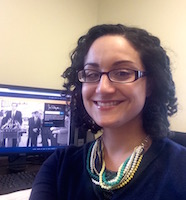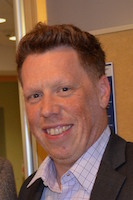This post is part of an ongoing series where the people behind Omeka-powered sites talk about their content, process, and working with Omeka. In this post, Wyatt and Danielle Emerling share their thoughts on building the website The Great Society Congress.


Jay Wyatt is Director of Programs and Research at the Robert C. Byrd Center for Congressional History & Education, and Danielle Emerling is Assistant Curator, Congressional and Political Papers Archivist, at the West Virginia University Libraries. They co-curate The Great Society Congress exhibit, a project of the Association of Centers for the Study of Congress. The exhibit team includes Debbie Davendonis-Todd, Baylor Collections of Political Materials; Sarah D’Antonio, Robert J. Dole Institute of Politics; and Hope Grebner, Drake University.
1. Would you briefly explain how you came to the project
Jay: Developing some sort of collaborative project that drew on materials based in ACSC member collections had been an unrealized organizational goal for a few years before we actually started on The Great Society Congress project. The subject was broached during a panel session at the ACSC’s 2014 annual meeting that Danielle and I attended, and afterward we began talking informally about how we could move forward with such a project. That was early summer 2014.
Going the way of a digital exhibit quickly emerged as the best option, as doing so allowed us to keep costs down and easily overcome obstacles like geographic distance by using readily accessible digital tools to work on documents and manage submissions.
We initially considered focusing specifically on the Voting Rights Act of 1965. But after doing some research on the Great Society, we decided to expand the project to cover the full 89th Congress (1965-1966). Taking on the larger project allowed us to highlight the pivotal role that Congress played in creating the Great Society on the occasion of its 50th anniversary.
2. What made you decide to use Omeka?
Danielle: We used Omeka at the University of Delaware Library, where I worked at the time, to create the 22 Months: Ted Kaufman in the U.S. Senate exhibit, and we liked a lot of its features. We could use an array of item types and easily add descriptive metadata to those items. We could control the content and layout for the exhibit without having extensive web design skills, and we did not need to rely on IT staff to support the site beyond installing Omeka on a server. For these reasons, and because it’s easy for multiple users to contribute to a project, ACSC decided to use Omeka. The UD Library agreed to host our digital exhibit, and the Web Services and Digital Humanities Librarian, Audrey Hamelers, worked with us to create the “widescreen” template for the site.
3. Has using Omeka changed the way you think about content? If so, how?
Jay: Definitely. As a historian, managing materials the way an archivist or curator normally does wasn’t something I had much experience with before working on The Great Society Congress. As a result, I wasn’t thinking so much about how incorporating each document’s metadata and making it available to visitors would enhance the exhibit early on. I was more focused on the design layout and what the user experience would be like. But because Omeka allows for the inclusion of metadata for each document, we’ve been able to create an exhibit that is visually engaging and informative and also a fantastic tool for conducting primary source research on the 89th U.S. Congress, the legislation of the Great Society, and the broader political environment of the mid-1960s. The Great Society Congress now contains more than 400 primary source documents, each with full metadata. Including this component has added a unique utility to the exhibit and prompted me to think a bit more broadly about the content we include in the exhibit.
Danielle: Curating this exhibit has been a unique opportunity to engage with archival materials from multiple institutions and collections and to sew them together into a narrative. The flexibility of Omeka allowed us to represent the multiple threads that emerged from ACSC members’ contributions. While our initial focus was the legislation passed in 1965-1966, we were able to broaden the exhibit to explore the Congress and that time period. We included content about the members of the 89th Congress and the rules and procedures that shaped the process of policy making. We wove in the perspectives of the American people and the larger social movements and international events that influenced action in Congress. In Omeka, we were able to create three exhibits that are brought together with simple pages to accommodate these three distinct areas – The 89th Congress, The Legislation, and The Political Environment.
4. What piece of advice would you give someone who wants to build a project like yours?
Jay: Plan, plan, plan well in advance. We started working on this project almost a year before we went live with the exhibit in April 2015. As a team, we did a great deal of research on various content management systems like Omeka, surveyed other popular digital history websites and exhibits in an attempt to define how we wanted the exhibit to look and function, and ultimately developed a framework for managing submissions. This was all in addition to the research we conducted on the Great Society and the 89th Congress itself. We met all of our goals and deadlines, but only because of the planning and organizing that we did early on.
Danielle: I second Jay’s advice! One of the most important things we developed was a content standard that provides guidance to contributors for interpreting and completing the Dublin Core fields for their materials. This made submissions much more consistent overall and saved our team a lot of time.
5. What is one of your favorite items from the site to share
Jay & Danielle: We both really like the constituent correspondence that is included throughout the exhibit, and especially in the Civil Rights and Vietnam features. The Civil Rights section alone contains more than thirty constituent letters, from individuals to their representatives and senators in Congress. They show in vivid detail Americans grappling with tough, complicated issues relating to social justice and, in regard to Vietnam, when, where, and how American military power should be used.
Jay: That said, my favorite document in the exhibit is a full color pamphlet produced by the Tobacco Institute, Inc. titled “Tobacco – A Vital U.S. Industry.” The pamphlet was submitted by NARA’s Center for Legislative Archives and is included in the exhibit feature profiling the Federal Cigarette Labeling and Advertising Act. The pamphlet includes several fantastic illustrations and images and was part of prolonged pushback by the tobacco industry against efforts to warn Americans of the dangers of smoking via warning labels on cigarette packaging and in advertising. Ultimately, the efforts failed, but the pamphlet provides interesting insight into how the tobacco lobby tried to position itself as a central part of the American economy in an effort to stave off new federal regulations, regardless of the larger public health implications.
Danielle: I really like a series of video clips captured during a 1966 congressional delegation trip to India, led by Representatives Robert Dole (R-KS) and W.R. Poage (D-TX), in which they surveyed the drought and food shortage in that country. The video has excellent content, but it didn’t exist in its current form before this exhibit. When we called for contributions from ACSC members, the Archives at the Robert J. Dole Institute of Politics and the W.R. Poage Legislative Library decided to work together on this issue of Food for Peace. The Poage Library found a silent film in their collections, and the Dole Archives realized they had recently digitized audio from the India trip. The video and audio matched! This resource is a great example of the benefits of a collaborative project like The Great Society Congress.